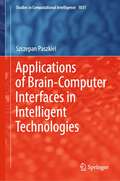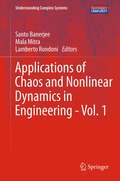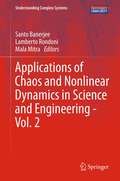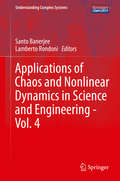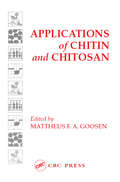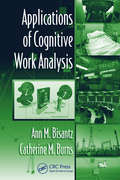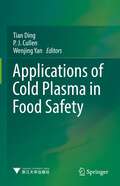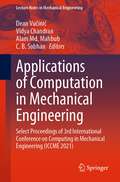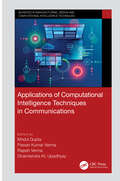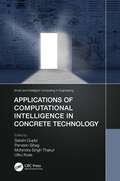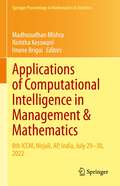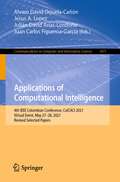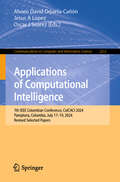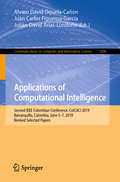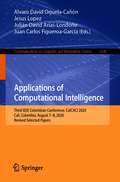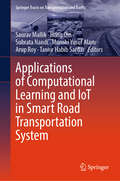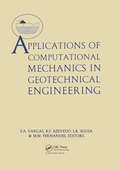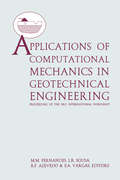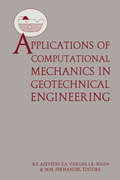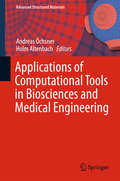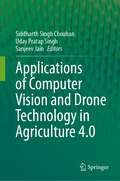- Table View
- List View
Applications of Brain-Computer Interfaces in Intelligent Technologies (Studies in Computational Intelligence #1031)
by Szczepan PaszkielThe BCI technology finds newer and newer implementations. Year by year, the number of publications in this field grows exponentially. This book attempts to describe the implementation of the brain-computer technology based on both STM32 and Arduino microcontrollers. In addition, the application of BCI technology in the field of intelligent houses, robotic lines as well as in the field of bionic prostheses was presented. One of the chapters of the monograph also discusses the issue of fMRI in the context of the possibility of analyzing images made as part of fMRI through solutions based on machine learning. A practical implementation of the TensorFlow framework was presented. The fMRI technique is also often implemented in BCI solutions. The conducted literature studies show that the technology of BCI is undoubtedly a technology of the future. However, there is a need for continuous development of biomedical signal processing methods in order to obtain the most efficient implementations in the case of non-invasive implementation of BCI technology based on EEG. The further development of BCI technology has a huge impact on the techniques of rehabilitation of people with disabilities. Nowadays, wheelchairs are being constructed, thanks to which a disabled person is physically able to direct his position in a certain direction and at a certain speed. Thanks to BCI, it is also possible to create an individual speech synthesizer, with the help of which a paralyzed person will be able to communicate with the outside world. New limb prostheses that will replace the lost locomotor system in almost one hundred percent are still being developed. Some prostheses are connected to the human nervous system, thanks to which they are able to send feedback to our brain about the shape, hardness and temperature of the object held in the artificial limb.
Applications of Chaos and Nonlinear Dynamics in Engineering - Vol. 1 (Understanding Complex Systems)
by Lamberto Rondoni Santo Banerjee Mala MitraChaos and nonlinear dynamics initially developed as a new emergent field with its foundation in physics and applied mathematics. The highly generic, interdisciplinary quality of the insights gained in the last few decades has spawned myriad applications in almost all branches of science and technology--and even well beyond. Wherever quantitative modeling and analysis of complex, nonlinear phenomena is required, chaos theory and its methods can play a key role. This volume concentrates on reviewing the most relevant contemporary applications of chaotic nonlinear systems as they apply to the various cutting-edge branches of engineering. The book covers the theory as applied to robotics, electronic and communication engineering (for example chaos synchronization and cryptography) as well as to civil and mechanical engineering, where its use in damage monitoring and control is explored). Featuring contributions from active and leading research groups, this collection is ideal both as a reference and as a 'recipe book' full of tried and tested, successful engineering applications
Applications of Chaos and Nonlinear Dynamics in Science and Engineering - Vol. 2 (Understanding Complex Systems)
by Lamberto Rondoni Santo Banerjee Mala MitraChaos and nonlinear dynamics initially developed as a new emergent field with its foundation in physics and applied mathematics. The highly generic, interdisciplinary quality of the insights gained in the last few decades has spawned myriad applications in almost all branches of science and technology--and even well beyond. Wherever the quantitative modeling and analysis of complex, nonlinear phenomena are required, chaos theory and its methods can play a key role. This second volume concentrates on reviewing further relevant, contemporary applications of chaotic nonlinear systems as they apply to the various cutting-edge branches of engineering. This encompasses, but is not limited to, topics such as the spread of epidemics; electronic circuits; chaos control in mechanical devices; secure communication; and digital watermarking. Featuring contributions from active and leading research groups, this collection is ideal both as a reference work and as a 'recipe book' full of tried and tested, successful engineering applications.
Applications of Chaos and Nonlinear Dynamics in Science and Engineering - Vol. 3 (Understanding Complex Systems)
by Lamberto Rondoni Santo BanerjeeChaos and nonlinear dynamics initially developed as a new emergent field with its foundation in physics and applied mathematics. The highly generic, interdisciplinary quality of the insights gained in the last few decades has spawned myriad applications in almost all branches of science and technology--and even well beyond. Wherever quantitative modeling and analysis of complex, nonlinear phenomena is required, chaos theory and its methods can play a key role. This third volume concentrates on reviewing further relevant contemporary applications of chaotic nonlinear systems as they apply to the various cutting-edge branches of engineering. This encompasses, but is not limited to, topics such fluctuation relations and chaotic dynamics in physics, fractals and their applications in epileptic seizures, as well as chaos synchronization. Featuring contributions from active and leading research groups, this collection is ideal both as a reference and as a 'recipe book' full of tried and tested, successful engineering applications.
Applications of Chitan and Chitosan
by MATTHEUS F.A. GOOSENThe main driving force behind the development of new applications for chitin and its derivative chitosan lies with the fact that these polysaccharides represent a renewable source of natural biodegradable polymers. Since chitin is the second most abundant natural polymer, academic as well as industrial scientists are faced with a great challenge to find new and practical applications for this material. This book provides an examination of the state of the art, and discusses new applications as well as potential products. Applications of Chitin and Chitosan deals almost exclusively with applications. Previous books in the field have devoted less than 30% of their material to commercial or medical uses. In the past thirty years, substantial progress has been made on fundamental and applied research in chitosan technology. One of the driving forces behind this rapid development has been the decrease in the supply of natural resources. At the same time there has been an increased realization that there are abundant alternative bioresources. Two factors-economics and versatility-have also stimulated interest in chitosan's utilization in various fields. Chitin and chitosan derivatives have applications in fields that range from fertilizers to pharmaceuticals. Chitosan is no longer just a waste by-product from the seafood processing industry. This material is now being utilized by industry to solve problems and to improve existing products, as well as to create new ones.Applications of Chitin and Chitosan is illustrated with over 100 photos, charts, graphs and figures and more than 40 tables. Applications of Chitin and Chitosan will be of interest to industrial personnel involved in bioprocessing as well as bioengineering students, specialists in the biomedical and biopharmaceutical industry, biochemists, food engineers, environmentalists, and microbiologists and biologists who specialize in chitosan technology. Publication: Fall 1996.
Applications of Cognitive Work Analysis
by Catherine M. Burns Ann M. BisantzDespite continued interest in Cognitive Work Analysis (CWA) techniques for the analysis and design of complex, human-technology systems, few published accounts exist that document all of the five recommended phases of CWA in real world applications. Delineating a work-centered conceptual framework that guides the design of technology, Applications
Applications of Cold Plasma in Food Safety
by P. J. Cullen Tian Ding Wenjing YanThis book provides readers with a comprehensive overview of cold plasma technology for tackling the various food-related hazards in a wide range of food sectors. The principles and characteristics of cold plasma generation in gas and its interaction with liquids, as well as its combating modes of action for common hazards (e.g., bacteria, spores, biofilms, fungi, and fungal toxins) are emphasized in this book. It also presents the applications of cold plasma or its hurdles with other techniques to assure the microbiological safety of the key food classifications, including fruits, vegetables, cereals, grains, meat, aquatic products, liquid food products (e.g., juices, milk), nuts, spices, herbs, and food packaging. This book is useful for researchers to grasp the comprehensive understandings of how food safety can be controlled with cold plasma technology. This book also provides adequate information for engineers in food industry for better development and optimization of the plasma-generating systems. Government institutions that are responsible for food safety regulations can understand more knowledge about the intricacies and influencing factors, which should be considered for regulating the applications of cold plasma technology in food.
Applications of Computation in Mechanical Engineering: Select Proceedings of 3rd International Conference on Computing in Mechanical Engineering (ICCME 2021) (Lecture Notes in Mechanical Engineering)
by C. B. Sobhan Dean Vučinić Vidya Chandran Alam Md. MahbubThis volume includes select peer reviewed proceedings from the 3rd International Conference on Computing in Mechanical Engineering (ICCME 2021) discussing the application of computer based simulations in mechanical and allied engineering disciplines. The book shows advanced applications of numerical techniques in different areas of mechanical engineering. The topics covered include numerical modelling, simulations and optimization best practices in various challenging domains like fluid dynamics, combustion in IC engines, heat transfer analysis, vibration damping and control, chemical and process engineering, mechanics of machining, nano fluidics and material science. This book will be a useful resource to students, researchers and engineers working on multidisciplinary engineering problems, specially focusing on mechanical engineering and applied mathematics issues, with hope that it will impact future developments in engineering disciplines and motivate advancements and innovations in technical sciences.
Applications of Computational Intelligence Techniques in Communications (Advances in Manufacturing, Design and Computational Intelligence Techniques)
by Mridul Gupta, Pawan Kumar Verma, Rajesh Verma and Dharmendra Kr. UpadhyayThe book titled "Applications of Computational Intelligence Techniques in Communications" is a one-stop platform for the researchers, academicians, and people from industry to get a thorough understanding of the latest research in the field of communication engineering. Over the past decade, a manyfold increase in the use of computational intelligence techniques has been identified for obtaining the most optimal and timely solution to a problem. The various aspects covering the significant contribution of numerous computational intelligence techniques have been discussed in detail in this book. Today’s era of machine learning and Internet of Things (IoT) is demanding as high as possible data rate which has resulted into tremendous increased speed of communication. To match-up the pace, the computational intelligence is posing to be the most efficient and favourite tool. The book aims to cover the current technological advancements in the field of communication engineering and give a detailed prospect of computational intelligence to its readers. This book will be a great support to the people working in the field of IoT, machine learning, healthcare, optimization, filter design, 5G and beyond, signal processing etc. The chapters included here will expose its audience to various newly introduced and advanced computational intelligence techniques applicable in communication domain. The readers will be exposed multiple interdisciplinary areas of research in communication and will get the motivation to work in collaboration with other professionals from both the academia and industry.
Applications of Computational Intelligence in Concrete Technology (Smart and Intelligent Computing in Engineering)
by Sakshi GuptaComputational intelligence (CI) in concrete technology has not yet been fully explored worldwide because of some limitations in data sets. This book discusses the selection and separation of data sets, performance evaluation parameters for different types of concrete and related materials, and sensitivity analysis related to various CI techniques. Fundamental concepts and essential analysis for CI techniques such as artificial neural network, fuzzy system, support vector machine, and how they work together for resolving real-life problems, are explained. Features: It is the first book on this fast-growing research field. It discusses the use of various computation intelligence techniques in concrete technology applications. It explains the effectiveness of the methods used and the wide range of available techniques. It integrates a wide range of disciplines from civil engineering, construction technology, and concrete technology to computation intelligence, soft computing, data science, computer science, and so on. It brings together the experiences of contributors from around the world who are doing research in this field and explores the different aspects of their research. The technical content included is beneficial for researchers as well as practicing engineers in the concrete and construction industry.
Applications of Computational Intelligence in Management & Mathematics: 8th ICCM, Nirjuli, AP, India, July 29–30, 2022 (Springer Proceedings in Mathematics & Statistics #417)
by Nishtha Kesswani Imene Brigui Madhusudhan MishraComputational intelligence consists of those techniques that imitate the human brain and nature to adopt the decision-making approach. This book contains selected papers from the 8th International Conference on Computers, Management and Mathematical Sciences (ICCM) 2022 about fuzzy systems, neural networks and evolutionary computation that can address stochastic environments where reasoning is a significant attribute to derive potential solutions and focus on the business domain's computational aspects.This is a conference proceedings for scholars/students who are using the powerful algorithms, concepts and principles of computational intelligence in a wide spectrum of research cases.
Applications of Computational Intelligence: 4th IEEE Colombian Conference, ColCACI 2021, Virtual Event, May 27–28, 2021, Revised Selected Papers (Communications in Computer and Information Science #1471)
by Juan Carlos Figueroa-García Alvaro David Orjuela-Cañón Julián David Arias-Londoño Jesus A. LopezThis book constitutes revised and extended selected papers of the 4th IEEE Colombian Conference, ColCACI 2021, which was held virtually in Colombia at the end of May 2021.The 7 full papers presented in the volume were carefully reviewed and selected from 22 submissions. The papers are organized in topical sections on biomedical applications and alternative proposals and its applications.
Applications of Computational Intelligence: 5th IEEE Colombian Conference, ColCACI 2022, Cali, Colombia, July 27–29, 2022, Revised Selected Papers (Communications in Computer and Information Science #1746)
by Juan Carlos Figueroa-García Jesus Lopez Alvaro David Orjuela-Cañón Julian David Arias-LondoñoThis book constitutes the refereed proceedings of the 5th IEEE Colombian Conference on Applications of Computational Intelligence, ColCACI 2022, held in Cali, Colombia during July 27–29, 2022.The 7 extended papers included in this book were carefully reviewed and selected from 38 submissions. They were organized in topical sections as follows: Design of a segmentation and classification system for seed detection based on pixel intensity thresholds and convolutional neural networks.
Applications of Computational Intelligence: 6th IEEE Colombian Conference, ColCACI 2023, Bogota, Colombia, July 26-28, 2023, Revised Selected Papers (Communications in Computer and Information Science #1865)
by Alvaro David Orjuela-Cañón Julián David Arias-Londoño Jesus A LopezThis book constitutes the refereed proceedings of the 6th IEEE Colombian Conference on Applications of Computational Intelligence, ColCACI 2023, held in Bogota, Colombia during July 2023.A total of 11 full papers were carefully reviewed and selected from 42 submissions. They were organized in topical sections as follows: Biomedical Applications, Biological Applications, Engineering Applications.
Applications of Computational Intelligence: 7th IEEE Colombian Conference, ColCACI 2024, Pamplona, Colombia, July 17–19, 2024, Revised Selected Papers (Communications in Computer and Information Science #2212)
by Alvaro David Orjuela-Cañón Oscar J. Suarez Jesus A. LopezThis book CCIS 2212 constitutes the referred proceedings of the 7th IEEE Colombian Conference on Applications of Computational Intelligence, ColCACI 2024, held in Pamplona, Colombia, during July 17–19, 2024. The 11 full papers were carefully reviewed and selected from 35 submissions. They explore various topics in the area of computational intelligence (CI), such as solar and photovoltaic forecasting, microseismical signal analysis, LLM performance analysis, evolution in translate systems, recognition of actors and peacebuilding, control in autonomous vehicles, and electroencephalography signals analysis.
Applications of Computational Intelligence: Second IEEE Colombian Conference, ColCACI 2019, Barranquilla, Colombia, June 5-7, 2019, Revised Selected Papers (Communications in Computer and Information Science #1096)
by Juan Carlos Figueroa-García Alvaro David Orjuela-Cañón Julián David Arias-LondoñoThis book constitutes the thoroughly refereed proceedings of the Second IEEE Colombian Conference, ColCACI 2019, held in Barranquilla, Colombia, in June 2019. The 21 full papers presented were carefully reviewed and selected from 59 submissions. The papers cover such topics as video processing; biomedical systems; image processing, etc.
Applications of Computational Intelligence: Third IEEE Colombian Conference, ColCACI 2020, Cali, Colombia, August 7-8, 2020, Revised Selected Papers (Communications in Computer and Information Science #1346)
by Juan Carlos Figueroa-García Jesus Lopez Alvaro David Orjuela-Cañón Julián David Arias-LondoñoThis book constitutes revised and extended selected papers of the Third IEEE Colombian Conference, ColCACI 2020, held in Cali, Colombia, August 2020. Due to the COVID-19 pandemic the conference was held online. The12 full papers presented were carefully reviewed and selected from 65 submissions. The papers are organized in topical sections on earth sciences applications; biomedical and power applications; alternative proposals and its applications.
Applications of Computational Learning and IoT in Smart Road Transportation System (Springer Tracts on Transportation and Traffic #22)
by Hong Qin Saurav Mallik Tanvir Habib Sardar Subrata Nandi Munshi Yusuf Alam Arup RoyThis book discusses machine learning and AI in real-time image processing for road transportation and traffic management. There is a growing need for affordable solutions that make use of cutting-edge technology like artificial intelligence (AI), machine learning (ML), and the Internet of Things (IoT). The efficiency, sustainability, and safety of transport networks can be greatly increased by implementing an Internet of Things (IoT) and machine learning (ML)-based smart road transport system. Install sensors on roadways and intersections to gather data on traffic conditions in real time, such as vehicle density, speed, and flow. Predicting traffic patterns is done by analyzing the gathered data using machine learning algorithms. This can lessen traffic, enhance overall traffic management, and optimize traffic signal timings. Vehicles equipped with Internet of Things devices can have their health monitored in real time. Parameters including lane changes, brake condition, tire pressure, and engine performance can all be monitored by sensors. Based on the gathered data, ML models are used to forecast probable maintenance problems. By scheduling preventive maintenance, failures can be avoided and overall road safety can be increased. Create a smartphone app that would enable drivers to locate parking spots in their area. To forecast parking availability based on past data, the time of day, and special events, apply machine learning algorithms. Integrate Internet of Things (IoT) sensors into fleet vehicles to monitor their performance, location, and fuel consumption. To maximize fleet efficiency, reduce fuel consumption, and plan routes more effectively, apply machine learning algorithms. Train ML models to forecast the quickest and most efficient routes with the help of historical data analysis. Route recommendations for drivers or fleet management systems can be constantly adjusted with real-time updates, which contain real-time data on road conditions, accidents, and construction. To guarantee smooth integration and efficient implementation, government organizations, transportation providers, and technology firms must work together.
Applications of Computational Mechanics in Geotechnical Engineering
by E.A.VARGAS; R.F.AZEVEDO; L.M.RIBEIRO E SOUSA; M.MATOS FERNANDESThe development of constitutive relations for geotechnical materials, with the help of numerical models, have increased notably the ability to predict and to interpret the mechanical behaviour of geotechnical works. This work covers rock excavations, soil excavations, earth fills and dams.
Applications of Computational Mechanics in Geotechnical Engineering
by M. Matos Fernandes, L. Ribeiro E Sousa, R.F. Azevedo and E.A. VargasThe third international workshop on applications of computational mechanics in geotechnical engineering discussed the area of computational mechanics applied to geotechnical problems. During the event, topics such as ground reinforcement and computational models were covered.
Applications of Computational Mechanics in Geotechnical Engineering
by R.F. Azevedo & E.A. VargasThe development of constitutive relations for geotechnical materials, with the help of numerical models, have increased notably the ability to predict and to interpret mechanical behaviour of geotechnical works. These proceedings cover the applications of computational mechanics in this area.
Applications of Computational Methods in Manufacturing and Product Design: Select Proceedings of IPDIMS 2020 (Lecture Notes in Mechanical Engineering)
by B. B. Biswal Pankaj C. Jena B. B. V. L. Deepak D. R. K. ParhiThis book presents the select proceedings of the conference of Innovative Product Design and Intelligent Manufacturing System (IPDIMS 2020), held at the National Institute of Technology, Rourkela, India. The book addresses latest methods and advanced tools from different areas of design and manufacturing technology. The main topics covered include computational methods for robotics, mechatronics and human-computer interaction; computer-aided design, manufacturing and engineering; aesthetics, ergonomics and UX/UI design; smart manufacturing and expert systems. The contents of this book will be useful for researchers as well as professionals working in the areas of industrial design, mechatronics, robotics, and automation.
Applications of Computational Tools in Biosciences and Medical Engineering (Advanced Structured Materials #71)
by Andreas Öchsner Holm AltenbachThis monograph presents the latest developments and applications of computational tools related to the biosciences and medical engineering. Computational tools such as the finite element methods, computer-aided design and optimization as well as visualization techniques such as computed axial tomography open completely new research fields with a closer joining of the engineering and bio/medical area. Nevertheless, there are still hurdles since both directions are based on quite different ways of education. Often even the "language" is sometimes different from discipline to discipline. This monograph reports the results of different multi-disciplinary research projects, for example, from the areas of scaffolds and synthetic bones, implants and medical devices and medical materials. It is also shown that the application of computational methods often necessitates mathematical and experimental methods.
Applications of Computer Vision and Drone Technology in Agriculture 4.0
by Sanjeev Jain Siddharth Singh Chouhan Uday Pratap SinghThis edited book focus on two most emerging areas and covers the different aspects of computer vision and drone technology in the field of agriculture. It comprises various applications including segmentation/classification of plant diseases, monitoring of crops, grade/quality estimation of fruits/flowers/vegetables/crops, surveillance, soil deficiency estimation, crop/plant growth estimation, canopy measurement, water stress management, vegetation indices calculation, weed detection, and spraying, among other. It has 17 chapters contributed by experts in the field of computer vision, drone technology, deep learning, machine learning, artificial intelligence, image processing, agriculturist, and plant pathologists. The recent development of high-end computing devices and the adaptation of unmanned aerial vehicles has provided a mechanism to automate traditional agriculture practices. The on-field or aerial images captured using cameras are processed with the help of intelligent algorithms, and an assessment is drawn for further recommendations. This practice is efficient in provisioning an accurate, timely, and economical decision-making system to overcome the problems of agricultural field experts and farmers. This process is advantageous in increasing the quality and quantity of crop yields. This book serves as an excellent guide to students, researchers, scientists, and field experts in directing their work toward this domain and developing/designing models. Further, this book is useful for pathologists, biotechnologists, seed production specialists, breeders, market managers, and other stakeholders associated with underlying technology or market development from the public and private sectors.
Applications of Cuckoo Search Algorithm and its Variants (Springer Tracts in Nature-Inspired Computing)
by Nilanjan DeyThis book highlights the basic concepts of the CS algorithm and its variants, and their use in solving diverse optimization problems in medical and engineering applications. Evolutionary-based meta-heuristic approaches are increasingly being applied to solve complicated optimization problems in several real-world applications. One of the most successful optimization algorithms is the Cuckoo search (CS), which has become an active research area to solve N-dimensional and linear/nonlinear optimization problems using simple mathematical processes. CS has attracted the attention of various researchers, resulting in the emergence of numerous variants of the basic CS with enhanced performance since 2019.
